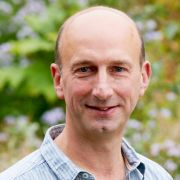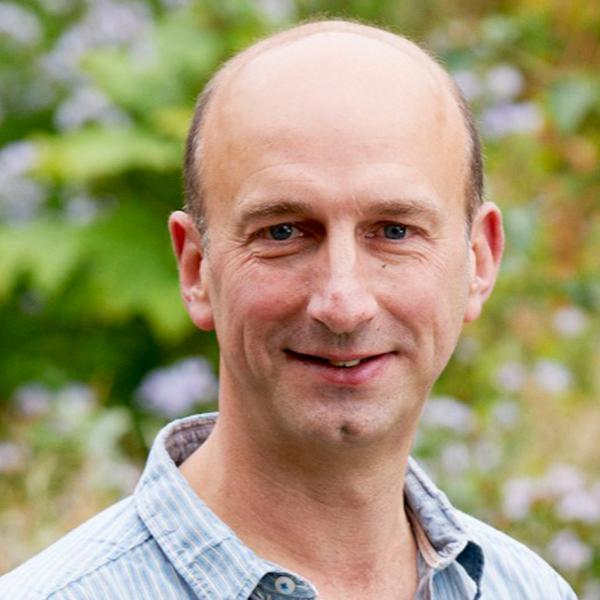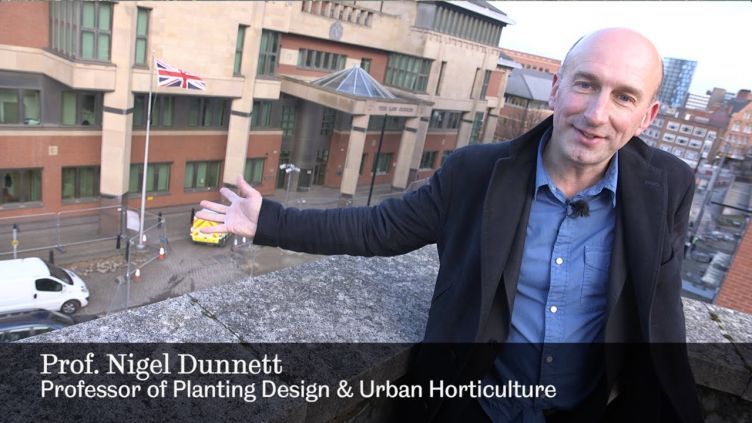Professor Nigel Dunnett
B.Sc PhD
School of Architecture and Landscape
Professor of Planting Design and Vegetation Technology


+44 114 222 0611
Full contact details
School of Architecture and Landscape
12.10
Arts Tower
Western Bank
Sheffield
S10 2TN
- Profile
-
The promotion of urban environments that are rich in vegetation and nature is central to my teaching and research. This work combines and integrates my background and experience in both horticulture and ecology.
While ecological ideas in landscape architecture have usually been applied at the larger scale, my focus is generally at the smaller scale: in gardens, urban parks, and on and around buildings and in high-density built development.
All aspects revolve around exciting and novel uses of plants, planting design and application of ecological ideas to achieve low-input, dynamic, diverse, colourful and ecologically-tuned urban landscape. Applications of the work generally involve aspects of urban ecology or urban horticulture. My current teaching comprises planting design, landscape ecology, and ecological design and management.
Professional background
- 1986-1989: Freelance botanical surveyor, specializing in woodlands. Garden design and construction, with work in UK and Italy.
- 1994 – 2002: Lecturer, Department of Landscape, University of Sheffield
- 2003 – 2007: Senior Lecturer, Department of Landscape, University of Sheffield
- 2006 – present: Director. The Green Roof Centre, University of Sheffield
- 2007 – present: Reader in Urban Horticulture, Department of Landscape, University of Sheffield
- Qualifications
-
- 1981 - 1984: B.Sc Botany, University of Bristol
- 1985 - 1986: M.Sc Landscape Ecology, Design and Maintenance. Wye College, University of London
- 1989 - 1990: Garden Club of America Interchange Fellowship in Horticulture. North Carolina State University
- 1991 - 1996: PhD: long-term dynamics of herbaceous vegetation in roadside verges at Bibury, Gloucestershire. Department of Animal and Plant Sciences, University of Sheffield
- Research interests
-
My research activity is strongly interdisciplinary, focusing on the interface between ecology, design and horticulture in urban green space and built development, and has an active interaction with industry, national agencies, and local community groups. My research falls into four major areas:
- development of sustainable and innovative vegetation and planting design techniques
- the vegetation, planting and ecology of green roof systems
- rain Gardens and other landscape rainwater management features; d) long-term ecological monitoring
Current projects
2009 – 2013. EU Marie-Curie Industry Academia `Green Roof Systems´. Principal Investigator and Project Coordinator. £1.2 million over four years. 6 early career researchers (including 3 PhDs), 3 experienced researchers, and the exchange of permanent staff between the University of Sheffield and its industry partner in Germany, ZinCo GmbH.
2006 – 2009. EU Objective 1. `Green Roof Infrastructure Development Programme´. Principal Investigator and Project Coordinator. £820,000 over three years.
2010 – EPSRC Proof of Concept Fund. £825,000 over two years. Invesitgator.
Sustainable Planting Design
For the past 15 years I have worked to develop techniques for the application of ecological ideas, principles and techniques in the use of plants and vegetation in mainstream urban landscape contexts. This approach to urban planting, which combines native and non-native plant species in low-input systems based on semi-natural vegetation types, such as meadows, woodlands and wetlands, has come to be known as `The Sheffield School´ of planting design.This work, undertaken in close collaboration with Professor James Hitchmough, has received much national and world-wide attention. The key concepts behind this approach are outlined in the book for which I was the principal editor and contributing author: Dunnett, N. & Hitchmough, L. (2003) The Dynamic Landscape: the ecology, design and management of naturalistic urban planting (Routledge, London).
The key aspects of this work, which differentiates it from that of other planting design specialists in the field of contemporary naturalistic planting design approaches, is that it is specifically focused on urban greenspace, and that it addresses the major practical issues involved in such a context: limited budgets and resources, and a relatively low skills base in terms of maintenance.Working in an urban context at a wide range of scales means that biodiversity considerations are also highly important. However, in addition to satisfying environmental sustainability objectives, social sustainability is equally important: plantings, vegetations, spaces must be aesthetically acceptable.
Beauty, colour, seasonal change are prime considerations. By applying horticultural concepts to ecological plantings, and ecological concepts to horticultural plantings, the result can be very low-input plantings, with a very long season of visual interest, high biodiversity value, but which also, crucially, have a very high level of public approval.
In general this work involves species selection, research into establishment and maintenance techniques, the development of successful mixes of species to achieve aesthetic and functional objectives. Much of this work involves developing approaches to vegetating landscapes that are seed-based as well as plant-based.
I developed the concept of `Pictorial Meadows´ to describe the intention of a planting approach that was highly aesthetically driven, but which also had the dynamics, biodiversity and management advantages of meadow systems.The concept works across the board in terms of developing alternatives to traditional herbaceous and perennial planting approaches: directly-sown annuals and perennials that produce dramatic, exciting and very colourful long-lasting displays in a very wide range of contexts, from small gardens through to extensive areas in urban parks, alongside highways and in housing areas.
Research work involves trialing and screening of suitable species, development of seed mixtures for different visual effects, testing establishment and management methods, and crucially, assessing public responses. The resulting seed mixtures are now used widely in the UK and other countries, and receive a great deal of media interest. I developed the concept Current work involves ongoing plant trails and selection, development of new mixes, and the application of technological approaches to delivering such plantings, such as the use of pre-grown vegetation mats.
Another field of activity is Mixed Shrub and Herbaceous Plantings. I have pioneered the use of coppicing as a maintenance technique in shrub plantings to enable long-season mixtures of woody plants and herbaceous perennials to co-exist. Current interests involve applying similar naturalistic principles that are now popular for perennial and ornamental grass plantings to mixed plantings of shrubs and perennials, and to the establishment of woodland ground flora amongst ornamental shrubThe planting and Ecology of Green Roofs
My main focus in this research is to investigate the potential of vegetation and planting on roof and building surfaces. Research ranges from work with native plant communities and species, through to vegetations composed entirely of non-native plants – and all combinations in between.
In 2000 I established the first trials and experimentation with green roof plants in the UK, with the aim of selecting plant species suitable for the UK climate. This work has led to an extensive programme of plant-based research.
At Sheffield we now have the largest international green roof plant screening programme, and are currently working on the biggest re-evaluation of green roof systems since the technology was first developed in Germany, to develop new vegetations and other components of the system to meet the challenges of climate change.
In 2004 I published with Noel Kingsbury the first English language book devoted solely to extensive green roofs (Planting Green Roofs and Living Walls, Timber Press). In 2003 the Department of Landscape hosted the first National Green Roof Conference in the UK, followed by a highly successful second conference in 2006.
In 2006 I secured EU funding to establish the Green Roof Research and Demonstration Centre at the University of Sheffield, which is now the UK´s main centre for multi-disciplinary green roof research. In 2009 I secured further EU funding (£1.2 million) for the project `Green Roof Systems´, which seeks a fundamental re-evaluation of green roofs in the context of global climate change.
This project supports 6 early career researchers (including 3 PhDs), 3 experienced researchers, and the exchange of permanent staff between the University of Sheffield and its industry partner in Germany, ZinCo GmbH. In addition to the Marie Curie students, at least 5 other PG students are doing green roof research at the University of Sheffield.
Plant evaluation projects relate to plant tolerance of substrate depth and moisture regime. Particular focus is on species from dry meadow communities in the UK, North America and continental Europe, and in plants from calcareous grasslands across the temperate world. Other work is investigating the long-term dynamics of green roof systems, and exploring the influence of vegetation type on green roof performance
Rain Gardens
This area of investigation explores the potential of managing rainwater runoff in a range of urban situations to promote rich and diverse plantings. Unlike many SUDS or low-impact applications, the focus of this research is on what can be done in limited space alongside buildings, and is closely linked to the green roof work.
I wrote, with Andy Clayden, the first international book on this topic (Rain Gardens: Sustainable Management of Water in the Garden and Designed Landscape, Timber Press, 2007).
Long-term dynamics of herbaceous vegetation
I am the current recorder and database manager for the Bibury long-term data-set (initiated 1958) - the most comprehensive long-term monitoring study of semi-natural grassland vegetation in the world. The work initially formed the basis of my PhD in collaboration with Professor Arthur Willis or the Department of Animal and Plant Sciences.
With the death of Arthur Willis in 2006 I am now the lead investigator. Leverhulme funding gained in 2004 to undertake detailed investigation of the database. The findings from this research are of direct relevance to the application of ecological ideas to the design and management of herbaceous plantings in parks and gardens.
- Publications
-
Books
- Residential Landscape Sustainability. Wiley.


- The Dynamic Landscape. Taylor & Francis.


Journal articles
- Urban meadows as an alternative to short mown grassland : effects of composition and height on biodiversity. Ecological Applications, 29(6). View this article in WRRO


- Persistence, loss and gain : characterising mature green roof vegetation by functional composition. Landscape and Urban Planning, 185, 228-236.


- Plant species or flower colour diversity? Identifying the drivers of public and invertebrate response to designed annual meadows. Landscape and Urban Planning, 180, 103-113. View this article in WRRO


- Plant selection for rain gardens : response to simulated cyclical flooding of 15 perennial species. Urban Forestry & Urban Greening, 35, 57-65.


- Perceived species-richness in urban green spaces: Cues, accuracy and well-being impacts. Landscape and Urban Planning, 172, 1-10. View this article in WRRO


- The influence of vegetation on rain garden hydrological performance. Urban Water Journal, 14(10), 1083-1089. View this article in WRRO


- “Not in their front yard” The opportunities and challenges of introducing perennial urban meadows: A local authority stakeholder perspective. Urban Forestry and Urban Greening, 25, 139-149. View this article in WRRO


- Investigation of plant growth and flower performance on a semi-extensive green roof. Urban Forestry & Urban Greening, 23, 61-73. View this article in WRRO


- Biodiverse perennial meadows have aesthetic value and increase residents’ perceptions of site quality in urban green-space. Landscape and Urban Planning, 158, 105-118. View this article in WRRO


- Vegetation composition of old extensive green roofs (from 1980s Germany). Ecological Processes, 3(1).


- Investigation of weed phenology in an establishing semi-extensive green roof. Ecological Engineering, 58, 156-164.


- Park life. Planet Earth(SUMMER), 8-9.


- INVESTIGATION OF DYNAMIC CYCLES OF SEMI-EXTENSIVE GREEN ROOF. Acta Horticulturae(881), 653-660.


- Little evidence for limiting similarity in a long-term study of a roadside plant community. J ECOL, 98(2), 480-487.


- An Exploration of the Effect of Housing Unit Density on Aspects of Residential Landscape Sustainability in England. Journal of Urban Design, 14(2), 163-187.


- The promotion of grassland forb abundance: A chemical or biological solution?. BASIC APPL ECOL, 9(6), 653-662.


- The dynamics of planted and colonising species on a green roof over six growing seasons 2001–2006: influence of substrate depth. Urban Ecosystems, 11(4), 373-384.


- Influence of grass suppression and sowing rate on the establishment and persistence of forb dominated urban meadows. Urban Ecosystems, 11(1), 33-44.


- Green Roofs as Urban Ecosystems: Ecological Structures, Functions, and Services. BioScience, 57(10), 823-833.


- The impact of Rhinanthus minor in newly established meadows on a productive site. APPL VEG SCI, 10(1), 121-129.


- Woodland as a setting for housing-appreciation and fear and the contribution to residential satisfaction and place identity in Warrington New Town, UK. Landscape and Urban Planning, 79(3-4), 273-287.


- The impact of Rhinanthus minor in newly established meadows on a productive site. Applied Vegetation Science, 10(1), 121-129.


- Seeds of change: The value of using Rhinanthus minor in grassland restoration. J VEG SCI, 17(4), 435-446.


- Seeds of change: The value of using Rhinanthus minor in grassland restoration. Journal of Vegetation Science, 17(4), 435-435.


- Biodiversity, ecosystem function and plant traits in mature and immature plant communities. FUNCT ECOL, 19(2), 355-358.


- A new practical tool for deriving a functional signature for herbaceous vegetation. APPL VEG SCI, 7(2), 163-170.


- Nature, Role and Value of Green Space in Towns and Cities: An Overview. Built Environment, 29(2), 94-106.


- Perceived Benefits to Human Well-being of Urban Gardens. HortTechnology, 10(1), 40-45.


- Dynamics of Chamerion angustifolium in grassland vegetation over a thirty-nine-year period. PLANT ECOL, 148(1), 43-50.


- Competition as an amplifier of short-term vegetation responses to climate: an experimental test. FUNCT ECOL, 13(3), 388-395.


- The importance of transplant size and gap width in the botanical enrichment of species-poor grasslands in Britain. RESTOR ECOL, 7(3), 271-280.


- A 38-year study of relations between weather and vegetation dynamics in road verges near Bibury, Gloucestershire. J ECOL, 86(4), 610-623.


- DOES GULF-STREAM POSITION AFFECT VEGETATION DYNAMICS IN WESTERN-EUROPE. OIKOS, 73(3), 408-410.


Book chapters
- Index (pp. 193-197). Wiley


- Putting Residential Development in a Sustainable Context (pp. 1-28). Wiley


- Opportunities for Improving the Sustainable Profile of New Residential Developments (pp. 29-98). Wiley


- Creating a Residential Landscape Sustainability Checklist (pp. 99-120). Wiley


- Case Studies: Applying the Residential Landscape Sustainability Checklist (pp. 121-156). Wiley


- Appendix: Detailed Residential Landscape Sustainability Checklist (pp. 157-191). Wiley


- Resources: The raw materials of landscape, Landscape and Sustainability (pp. 179-201).


- Introduction to Naturalistic Planting in Urban Landscapes, The Dynamic Landscape (pp. 7-38). Taylor & Francis


- Landscape and Sustainability In Benson J & Roe M (Ed.) Taylor & Francis


Conference proceedings
- Frontmatter


- CLIMATE VEGETATION RELATIONSHIPS IN THE BIBURY ROAD VERGE EXPERIMENTS. LONG-TERM EXPERIMENTS IN AGRICULTURAL AND ECOLOGICAL SCIENCES (pp 271-285)


- Living in the Urban Wildwoods: A Case Study of Birchwood, Warrington New Town, UK (pp 95-116)


Reports
Datasets
- Residential Landscape Sustainability. Wiley.
- Teaching activities
-
- LSC 203 Landscape Ecology
- LSC 204 Introduction to Planting Design
- LSC 302 Ecological Design Project
- LSC 314 Current Topics in Landscape Ecology
- LSC 214 Field Techniques in Landscape Architecture
- LSC 6001 Ecological Design and Management
- Professional activities and memberships
-
- Royal Horticultural Society Ambassador for Greening Grey Britain
- Director of The Green Roof Centre
I strongly believe in forming partnerships with a wide range of organisations and groups to apply my research, to achieve change and to generate research data. Much of my research is `research through doing´ and practice-orientated.
As well as acting as a designer in my own right, and as a consultant to a wide range of schemes, I also contribute very regularly to `popular´ garden and horticulture magazines, and speak widely at international horticultural conferences.
In the field of planting design I have been part of the movement that has operated in Europe and North America for the last two decades, promoting a more relaxed and naturalistic approach to urban public plantings, and gaining inspiration from the structure and processes in natural vegetation systems. Recent design and consultancy activity includes:
- Lead horticultural and planting design consultant for the London 2012 Olympic Park, with Professor James Hitchmough (consultants to the scheme landscape architects: LDA/Hargreaves Associates)
- The Royal Bank of Canada Rain Garden at The London Wetland Centre
- Main Show Gardens for The Chelsea Flower Show, 2009 and 2011.
- The John Lewis Rain Garden
- The Barbican Roof Garden
- Invited Presentations
-
November 2010. World Skyrise Greening Conference, Singapore
-
September 2010. Keynote Speaker, World Green Roof Congress, London
-
June 2010. Keynote Speaker, GroWest Conference, Denver, Colorado
-
October 2009. World Green Roof Infrastructure Congress, Toronto
-
September 2009. ASLA Annual Conference, Chicago
-
September 2009. Keynote Speaker, 2nd Australian Green Roof conference, Melbourne,
-
June 2009. Keynote speaker in green roofs session, 2nd International Conference on Landscape and Urban Horticulture, Bologna, Italy
-
March 2009. Keynote Speaker, Davidson Horticultural Symposium, North Carolina
-
February 2009. Keynote Speaker, Garden and Landscape Design Association Annual Symposium, Dublin
-
October 2008. Keynote Speaker, ASLA conference, Philadelphia
-
September 2008. Keynote speaker, World Green Roof Congress, London
-
June 2008. Keynote speaker, 1st Australian National Green Roof Conference, Brisbane
-
May 2006. Graduate School of Design, Harvard.
-
March 2006. School of Landscape Architecture, University of Beijing, China.
-
March 2006 School of Landscape Architecture, Tsinghua University, Beijing, China.
-

